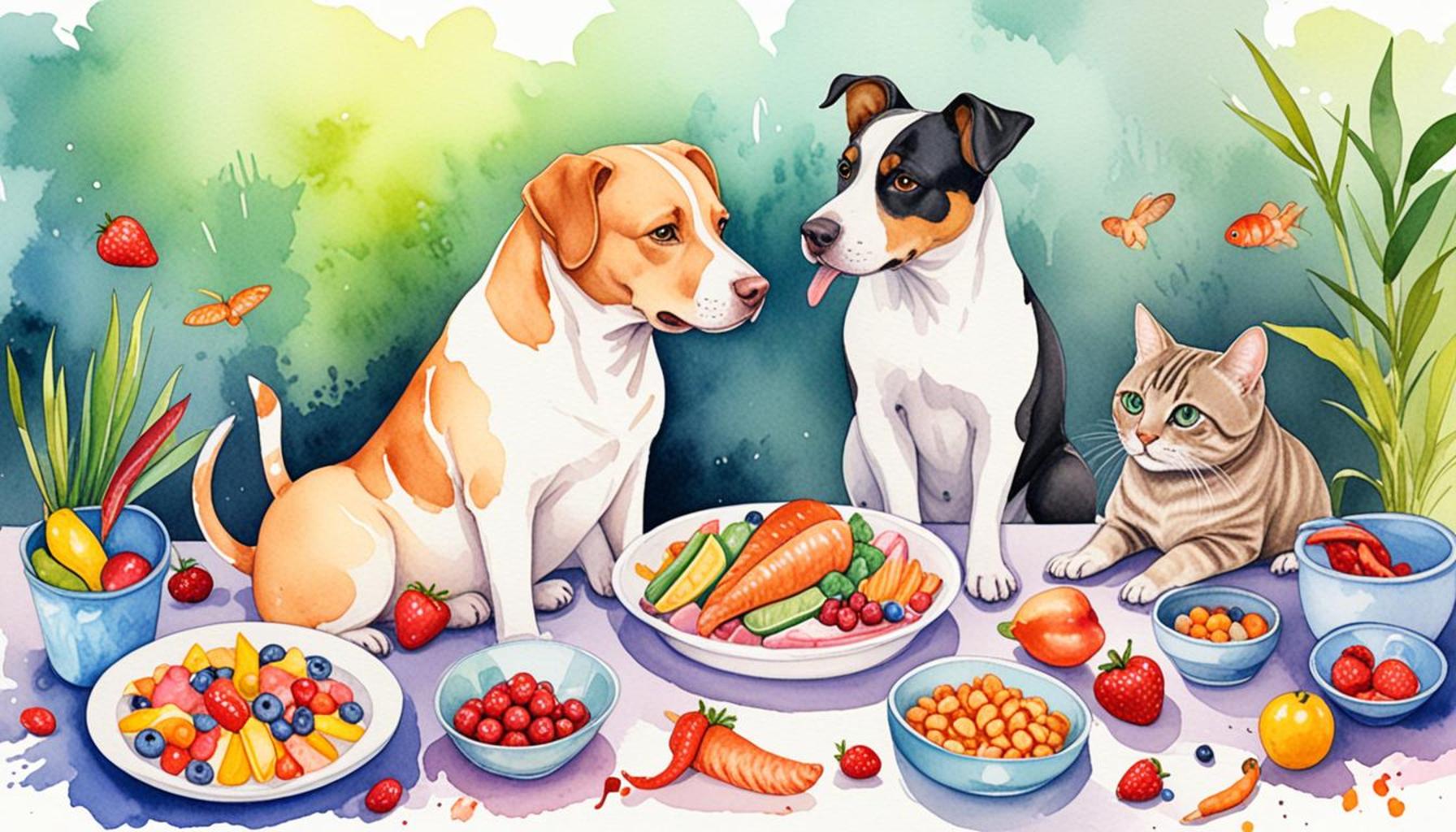Pet Food Behavior: Factors Influencing Preferences

Decoding Pet Food Choices
Understanding pet food behavior unveils fascinating insights into what drives our furry companions’ dietary choices, enriching our ability to cater to their needs. Pet owners often face perplexing questions about why their cats and dogs tend to gravitate towards certain foods. The answers to these inquiries are multi-faceted and reveal the intricate relationship between pet nutrition and behavior. Insight into these preferences can significantly enhance our pets’ health and happiness.
Key Factors Influencing Preferences
Several factors play a significant role in shaping pet food behavior, each contributing to a pet’s unique culinary inclinations.
- Taste and Texture: The appeal of flavor and texture is paramount in determining what pets eat. For instance, many cats exhibit a strong preference for fish-flavored foods—likely due to their evolutionary diets that relied heavily on fish and small prey. Similarly, dogs often show a bold inclination towards meat-based options, such as chicken or beef, which can be linked to their ancestral carnivorous roots. Moreover, textures play a pivotal role; some pets favor crunchy kibble, while others may prefer moist canned food, which might appeal to their instinctual behaviors.
- Brand Reputation: In an age of information overload, the credibility of a pet food brand is crucial. Popular brands like Purina and Blue Buffalo have built reputations based on quality and trustworthiness. Many pet owners rely on both personal recommendations and online reviews to guide their selections. Furthermore, transparency in ingredient sourcing and the absence of controversial additives can significantly sway owner choices.
- Health Concerns: A pet’s health can vastly shift their food preferences, with owners often making choices based on specific needs. For instance, dogs with grain allergies might benefit from limited-ingredient diets that cater to their sensitivities, while senior cats may need softer food that promotes easier digestion. The rise of specialty diets, such as ketogenic or raw food options, highlights how health considerations increasingly shape consumer choices.
- Owner Influence: The dietary patterns of pet owners can create a lasting impact on their pets’ consumption habits. Many pet owners unknowingly pass on their food preferences, as pets are often curious about the foods their humans enjoy. For example, a dog that frequently sees its owner eating chicken might develop a taste for it, while a cat that shares a home with a seafood-loving owner may similarly gravitate toward fish-based foods.
Each of these elements contributes to a complex tapestry of preferences that vary significantly from one pet to another. Engaging with the science behind pet food behavior opens doors to understanding how nutrition affects not only health but also the overall happiness of our beloved companions. This exploration beckons pet owners to delve deeper into their food choices, fostering an even stronger connection between them and their furry friends.
By undertaking a thoughtful examination of our pets’ diets, we can better appreciate their needs and enhance their quality of life. As the pet food landscape continues to evolve, leveraging understanding and awareness can lead to more informed, compassionate choices, ensuring our pets thrive in both health and happiness.
DIVE DEEPER: Click here for expert socialization techniques

Understanding Pet Food Choices
Delving into the intricacies of pet food behavior offers revealing insights into what drives our beloved companions’ dietary preferences. This understanding not only helps us cater to their nutritional needs more effectively but also strengthens the bond we share with them. For many pet owners, deciphering why their pets choose specific foods can be a conundrum. Recognizing the various factors influencing their preferences is essential in providing a well-rounded diet that promotes health and happiness.
The Role of Sensory Experience
A pivotal factor in shaping a pet’s food choices is its sensory experience. Both dogs and cats possess a strong ability to detect different flavors and textures, but their preferences may vary widely. Research has shown that dogs have a more pronounced sensitivity to certain flavors, particularly meats, which may stem from their evolutionary history as hunters. On the other hand, cats demonstrate an extraordinary attraction to foods with higher protein content, especially those featuring meat or fish, which are staples of their natural diets. This evolutionary link highlights the importance of offering foods that align with these instinctual cravings.
Health and Dietary Needs
Health concerns significantly influence a pet’s food preferences, often leading owners to make choices based on specific dietary needs. The growing awareness of pet nutrition has paved the way for an increasing variety of specialty diets. Here are some critical health factors that can steer food selection:
- Allergies: Pets with food sensitivities or allergies often require specific protein sources. For example, a dog with a chicken allergy may be more inclined to try novel proteins like duck or lamb.
- Aging: As pets age, their nutritional needs change dramatically. Senior pets may prefer softer, easily digestible foods that support their shifting metabolisms.
- Weight Management: Obesity in pets is a rising concern, prompting many owners to seek low-calorie diet options. Pets can demonstrate a preference for foods that satisfy their hunger without compromising health.
Such factors resonate greatly with pet owners, as they often respond by tailoring their pets’ diets to fulfill these evolving health requirements. Understanding these connections serves not only to promote better health outcomes but also to illuminate the complex relationship between diet and behavior.
The Influence of Environment and Routine
The environment in which pets are raised can greatly shape their food preferences. For instance, pets raised in homes where their human companions regularly indulge in certain cuisines may develop corresponding tastes. If a dog observes its owner enjoying vegetables such as carrots or peas, the dog may express interest in trying these foods. Similarly, the social environment can play a vital role; the presence of other pets can spark curiosity, leading to a willingness to sample a wider variety of foods.
The routines established within a household also influence pet food behavior. Predictable feeding times and consistent meal preparation can reinforce a pet’s preference for specific types of food. This stability creates an expectation in pets, making them more likely to accept their meals with enthusiasm when they recognize familiar patterns.
By gaining deeper insights into these factors influencing pet food behavior, owners can make informed choices that support their furry friends’ health and well-being while fostering a more enriching feeding experience. Understanding their preferences is a step toward promoting not only vital nutrition but also overall happiness.
The choice of pet food is influenced by various factors that pet owners consider essential in providing the best nutrition for their furry companions. Understanding these influencing factors can not only help pet owners make informed decisions but can also shed light on the evolving behavior surrounding pet food preferences.
One major factor is ingredient quality. Pet owners increasingly prioritize high-quality, natural ingredients in their selection of pet food. This trend towards premium products reflects a growing awareness of the impact of diet on pets’ health and well-being. Moreover, brand reputation plays a crucial role in influencing choices, as pet owners often gravitate towards brands that are perceived as trustworthy and offer transparency regarding their sourcing and production processes.
Another significant aspect is pet allergies and sensitivities. Many pets suffer from specific dietary restrictions, which compel owners to seek out specialized formulas that cater to these needs. This has led to an uptick in demand for grain-free options, limited ingredient diets, and hypoallergenic formulas, showcasing a growing awareness around pet health.
Adding to these considerations, the availability of veterinary recommendations can be pivotal in guiding pet owners towards the right food choices for their pets. Veterinarians often suggest specific diets for various conditions, influencing owners’ preferences. Additionally, marketing strategies and promotions by pet food companies are widely observed to impact consumer behavior, making certain products more appealing based on perceived added value.
| Category | Details |
|---|---|
| Ingredients Quality | Focus on natural, premium ingredients that support health. |
| Brand Reputation | Trustworthy brands enhance consumer confidence and choices. |
| Pet Allergies | Specialized diets for allergies drive preferences towards specific foods. |
| Veterinary Recommendations | Targeted suggestions guide choices, boosting confidence in decisions. |
In conclusion, by examining these factors such as ingredient quality, brand reputation, and recommendations from veterinarians, pet owners can navigate the complex choices available in the pet food market. These insights into pet food behavior can greatly influence dietary preferences, ultimately affecting pets’ well-being.
DON’T MISS: Click here to discover the benefits of pet adoption
Social Learning and Media Influence
Another critical aspect shaping pet food behavior is the phenomenon of social learning. Animals, akin to humans, are influenced significantly by their interactions with other pets and the cues they pick up from their surroundings. For example, if a dog observes another dog relishing a specific kibble or treat during a playdate, there’s a high likelihood that it will also want to try that particular food. This sharing of preferences often leads to a broader acceptance of diverse food options among pets. In households with multiple animals, these social dynamics can generate a lively mix of taste explorations.
Furthermore, the role of media cannot be understated in the context of pet food choices. In recent years, pet owners have increasingly turned to social media platforms for guidance on pet care, including food decisions. Influencer-led campaigns and viral posts showcasing trendy pet foods can sway owner choices significantly. These media influences lead to an expansion in the variety of foods available on the market, with products often marketed to appear more appealing through colorful packaging and attractive branding. As a result, pets may find themselves drawn to foods simply because they are popular, rather than strictly adhering to dietary needs or preferences.
Brand Loyalty and Marketing Strategies
Brand loyalty also plays a pivotal role in influencing pets’ food preferences. Many pet owners cultivate emotional ties to specific brands, often rooted in personal experiences or recommendations from veterinarians and pet care experts. Once pet owners find a brand that works for their pet—whether due to health improvements, acceptability of taste, or positive outcomes—there’s a tendency to remain loyal. This loyalty can be bolstered by marketing strategies that include endorsements from veterinarians, testimonials from other pet owners, and attractive packaging that emphasizes high-quality ingredients. Brands that can leverage this emotional connection often see enhanced engagement from both pets and their owners.
Moreover, understanding how pet food labels present nutritional information can also sway owner preferences. The allure of terms like “grain-free,” “organic,” and “natural” often captivates pet owners, steering their choices toward products that may not only promise better health outcomes but also align with their personal values regarding food sourcing and ingredients. Such marketing nuances encourage owners to consider a myriad of factors beyond a pet’s basic nutritional needs, extending the decision-making process and potentially complicating food selection.
Emotional Factors and Owner Pet Bond
On a deeper emotional level, the bond between pets and their owners significantly influences food behaviors. This connection often leads to thoughtful considerations about how food is selected, with owners desiring to provide meals that not only meet nutritional needs but also enhance the pet’s quality of life. For many owners, sharing meals or involving pets in food preparation creates a sense of participation that enriches the bond between human and animal. Such rituals, whether it’s preparing homemade meals or selecting gourmet treats, play into the emotions tied to caring for a pet, further positioning food preferences as a reflection of the owner’s affection and commitment.
By recognizing these facets—social learning, marketing influences, brand loyalty, and emotional connections—pet owners can take comprehensive steps to understand their pets’ dietary preferences. Adapting to these considerations fosters not only enhanced nutritional practices but also strengthens the overall relationship between pets and their families.
LEARN MORE: Click here to discover the benefits of balanced nutrition for your pet
Conclusion
In summary, understanding pet food behavior is a multifaceted endeavor that incorporates a variety of influences, including social dynamics, marketing strategies, emotional connections, and personal values. The intricate interplay between these factors not only shapes the preferences of pets but also guides the choices made by their owners. Social learning among pets can lead to new dietary explorations, while the marketing landscape—fueled by social media and psychological branding—creates a complex environment where choices can be swayed by trends rather than nutritional need.
Moreover, brand loyalty forms a significant part of the decision-making process, as personal experiences and recommendations build a sense of trust and commitment to specific products. The emotional bond fostered between pets and their owners leads to not just a desire for high-quality food but also an inclination to engage in shared experiences around meals. This connection transforms mealtime into an extension of love and care, influencing the selection process profoundly.
By delving into these various elements, pet owners are better equipped to make informed decisions regarding their pets’ diets, ensuring that choices align with both health and emotional well-being. As the pet food market continues to evolve, a deeper awareness of these underlying influences can enhance not only the pets’ nutritional practices but also the enriching bond shared with their human companions. For anyone interested in the dynamics of pet food behavior, further exploration into these trends can illuminate how we can nourish our beloved pets with their best interests at heart.


